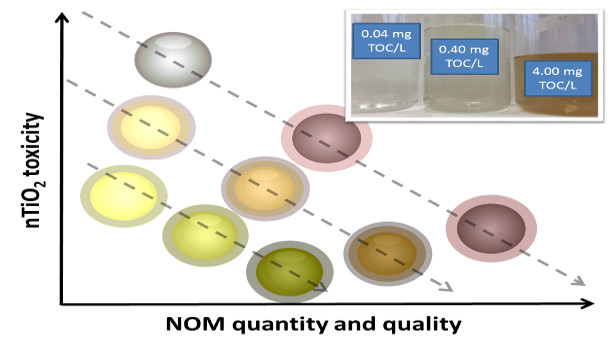In this post, Frank Seitz reports about their recent paper “Quantity and quality of natural organic matter influence the ecotoxicity of titanium dioxide nanoparticles”.

Graphic by F. Seitz
In our latest research paper, we focused on natural organic matters (NOM) inducing shifts in the ecotoxicity of titanium dioxide nanoparticles (nTiO2) for water fleas. In detail we wanted to know at which quantities and by which characteristics (NOM quality) the influence of NOMs on the acute nTiO2 toxicity for Daphnia magna is triggered. Therefore, we investigated two nTiO2 products (A-100 and P25; ~100 nm) in combination with seven NOM types of different quality at four concentrations each. We identified that the amount of NOM applied but also its quality plays an important role for the extent of the observed nTiO2 toxicity when investigating the immobility of daphnids after 96h of exposure. Larger amounts of NOM lowered the nTiO2 toxicity significantly. When focusing on the importance of the NOM quality, the NOM-characteristics aromaticity and hydrophobicity showed with increasing levels a substantial mitigating effect on the toxicity of the tested nanoparticles. Since NOM is ubiquitous in surface waters, the ecotoxicological risk of nTiO2 in waters with high NOM concentrations is most likely moderate for aquatic invertebrates. Nevertheless, interactions of nTiO2 and NOM with other stressors (e.g. natural or chemical) are not well-understood yet but are fundamental for a more reliable risk assessment of nanoparticles in general.
The paper was authored by Frank Seitz, Ricki R. Rosenfeldt, Marie Müller, Simon Lüderwald, Ralf Schulz, and Mirco Bundschuh and is published in Nanotoxicology.
The paper can also be retrieved by contacting the authors via their ResearchGate pages, e.g. via
You may also be interested in:
Food depletion as a mode of toxic action for nanoparticles
Palladium nanoparticles – a risk to for aquatic ecosystems?
The presence of titanium dioxide nanoparticles modifies copper toxicity

